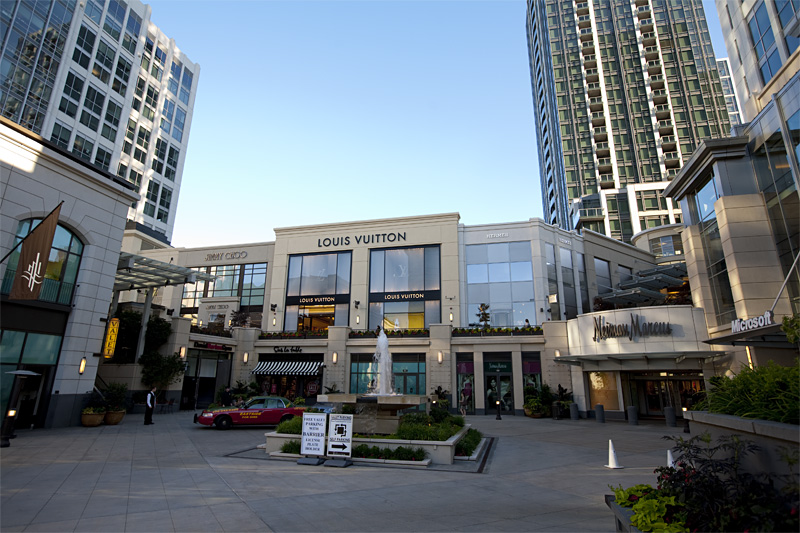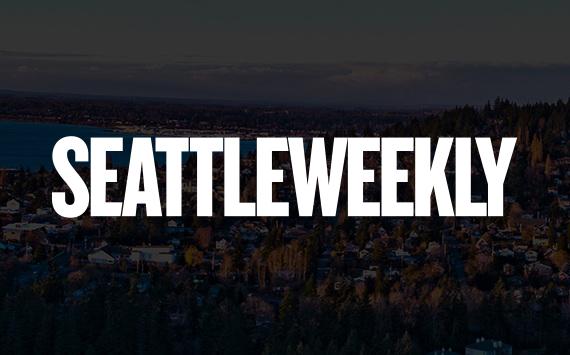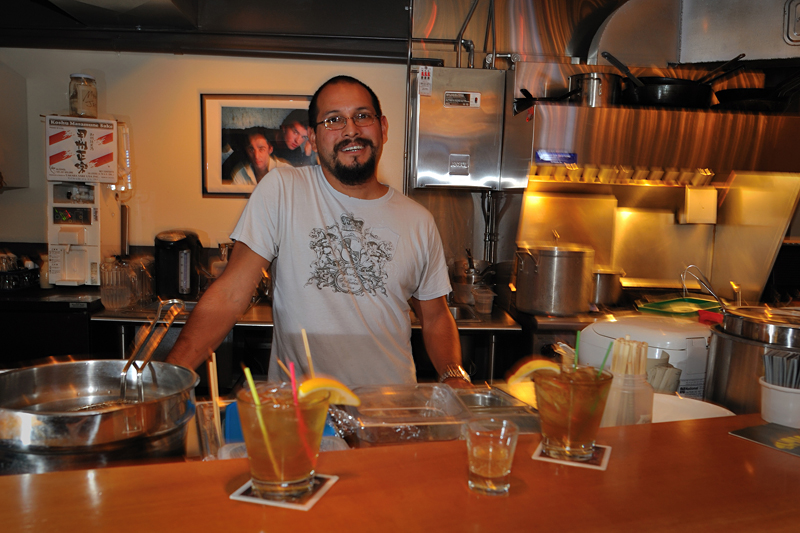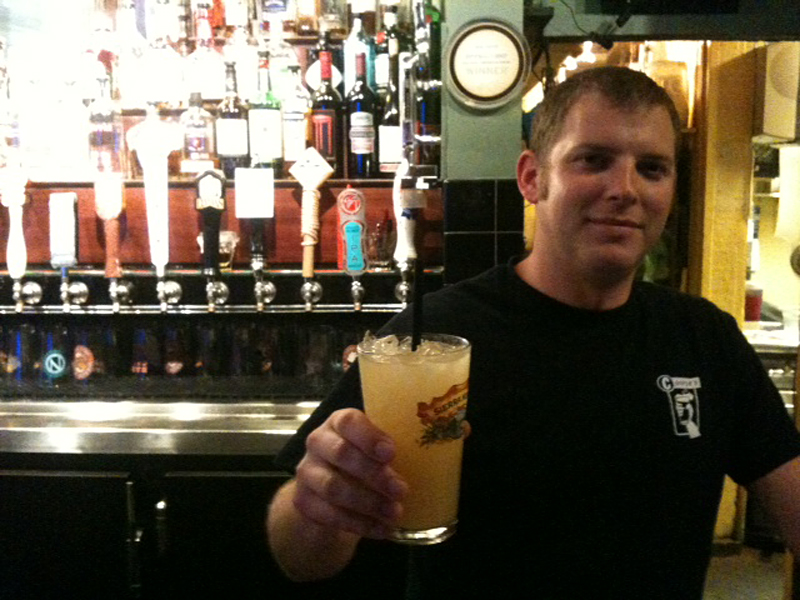A decade ago, Schnitzer West mostly built and ran office spaces in Bothell and Bellevue. The development company had never focused on the trendy mixed-use/residential market, having only the seafood restaurant Seastar and Starbucks as tenants in one of its downtown Bellevue office buildings.
As the real-estate boom heated up in the late ’90s, high-rise condos sitting atop trendy restaurants were springing up all around Puget Sound. And in 2000, Schnitzer started buying property in Capitol Hill and Belltown to build condominiums.
But Schnitzer didn’t make its biggest purchase in Seattle. Rather, it ventured across Lake Washington, snapping up an entire city block across the street from Bellevue City Hall.
On that parcel, the company started to develop a massive office/condo/retail project called The Bravern. Four towers were planned for the site: two smaller structures devoted to office space and two skyscrapers featuring luxurious condos. At the bottom would be a three-story, open-air luxury shopping center.
Everyone on the Eastside was making money at the time. In 2000 the median household income in Bellevue was $62,000, according to the U.S. Census Bureau. (In Seattle it was $45,000.) Schnitzer CEO Dan Ivanoff says his company started conducting focus groups and discovered that nouveau-riche Eastsiders were burnt out on casual clothing retailers. No more sport sandals and khakis—they wanted stores where one could purchase the wardrobe of a Sex and the City star without having to hop a plane for Manhattan.
“It wasn’t because we were hell-bent on luxury retail,” Ivanoff says. That’s just what the Eastside wanted, according to Schnitzer’s research. Turns out it wasn’t the only developer with big plans for the Eastside: The Bravern is just one of three massive mixed-use developments in downtown Bellevue to open since 2007. Bellevue-based Wasatch Development built two condo towers over 180,000 square feet of retail space a half-mile from The Bravern, which opened in September 2009. And two blocks away, Portland-based developer Gerding Edlen erected two condo buildings, the Bellevue Towers, topping 40 stories each. Altogether the three structures brought 1,366 new condominiums to downtown Bellevue, each towering over pedestrian-friendly plazas peppered with new restaurants and stores.
All three hit the market as the recession took hold. But rather than assume the developments were a mistake, local media hailed the openings as a sign that Bellevue was more capable of resisting the global economic downturn than most any other locality. In February 2009, while Seattle was choked by vacant condos and retail spaces, Seattle Metropolitan ran a cover story titled “The Rise of the Eastside: Look out, Seattle. Bellevue is gaining on you.”
It turns out Bellevue didn’t really possess that sort of economic Teflon. The recession simply landed there later, and this year the Eastside’s economy has shown signs of cracking, with restaurants shuttering and many of those beautiful new condos sitting empty. After watching Seattle’s city government fight to stay afloat across the water, Bellevue must now find ways to trim its own budget; tax revenue from real-estate sales has decreased by half since 2006.
That leaves Schnitzer and the future of ultra-luxury living in Bellevue on a precipice. In April, Ivanoff announced that one entire tower of condominiums would be leased as apartments. Meanwhile, the 215-unit condo tower (cheapest home: $320,000) remains literally empty as potential buyers look for loans from nervous banks. The Bravern has also lost high-profile commercial tenants, namely New York celebrity chef Terrance Brennan and his two restaurants.
Poor sales have already killed the investment of Gerding Edlen; the developer is in negotiations to turn the 558-unit Bellevue Towers over to its lenders, according to The Oregonian.
In order for The Bravern to avoid such a fate, all Schnitzer needs to do is sell its first $4.8-million penthouse and convince devoutly casual Northwesterners to start buying thousand-dollar sandals.
Take Exit 13 off I-405 North and you land among an idealized vision of the real-estate boom that commenced a decade ago. The streets are spotless, the sidewalks devoid of panhandlers, and the windows of half a dozen new skyscrapers shine in the sun.
City of Bellevue Office of Economic Development Director Robert Derrick says the seeds for this kind of downtown were sown 30 years ago. In the early 1980s, Bellevue’s City Council decided it no longer wanted to be merely a bedroom community for Seattle. They set about creating a downtown economic center, developing parks and encouraging builders to come in.
Walking among the skyscrapers now, it seems that Bellevue has been extremely successful in realizing its mission. Between buildings wafts aromas from dozens of downtown restaurants, not the stench of urine one finds along First Avenue across from Pike Place Market in Seattle.
As a workday closes, an astonishingly diverse group of men and women from all over the world stream out of their offices and make for nearby happy hours. More than 30 percent of Bellevue’s population is foreign-born and 32 percent is non-Caucasian, according to the U.S. Census Bureau. In comparison, fewer than 18 percent of Seattleites are immigrants, and about 29 percent of the population is a race other than white. Add Bellevue’s nationally recognized public schools, a gorgeous city park covering an entire block in the middle of downtown, and views of the surrounding mountains, and it’s easy to see why Money Magazine named Bellevue the fourth best city in the entire United States to call home.
All that factored into Schnitzer’s decision to go after the ultra-high-end luxury market, Ivanoff says. To make it all work, though, Schnitzer needed an anchor tenant, someone who would bring in patrons willing to spend up to quadruple digits on handbags and other accessories.
Ivanoff and Schnitzer’s Senior Investment Director, Tom Woodworth, first talked with handbag and shoe seller Kate Spade. Woodworth says they met with a commercial real-estate broker in New York to get a sense for their chances of landing such a tenant in Bellevue. The response, says Woodworth, amounted to “NFW”— no fucking way.
But the two men persisted, going after Kate Spade parent company Neiman Marcus. With its $6,400 handbags, Neiman Marcus makes Nordstrom look like a Ross Dress for Less. In 2006, Ivanoff and Woodworth traveled to the luxury department store’s Dallas headquarters to meet with CEO Burt Tansky.
“I think Burt expected [the meeting] would be about 10 minutes,” Ivanoff says. “We were there for two and a half hours.”
Wayne Hussey, Senior Vice President of Properties and Store Development at Neiman Marcus, says the luxury department store had been eyeing the Seattle area for at least a decade. Once every three years or so, he says, Neiman would take another look at demographics and spending habits here.
“It’s changed dramatically over the last number of years,” Hussey says, adding that not only was the Puget Sound area’s wealth increasing, but people were starting to buy designer labels as well, especially on the Eastside.
Interestingly, longtime Eastside developer Kemper Freeman says he had spent more than a decade trying to lure Neiman to downtown Bellevue. Freeman says that he paid for some of the company’s demographic studies, and thought he had locked it down as a tenant for Bellevue Square, which he owns. But Hussey says that when Schnitzer approached Neiman with its plans for a luxury-only retail development, his company shifted loyalties. “[The Bravern] wanted to have a better luxury environment, which obviously plays well into our business,” he says.
Ivanoff says he has the advantage of not being burdened by anything that could be considered less than total luxury. His building’s halls are wider than you find in most residential buildings. And each corner is protected by a metal plate to ensure that moving furniture won’t scuff the walls. The kitchens feature granite countertops, the bathrooms have Jacuzzi-style tubs, and even small condos boast spectacular views.
On the 33rd story, the penthouse has intentionally been left unfinished so that whoever buys the 5,000-square-foot top floor can customize the design and layout. But the outside balconies are all open, offering views of both the Olympic and Cascade ranges, Mt. Rainier, and, on a very clear day, Mt. Baker.
For the retail space, Ivanoff sought inspiration in the city that created luxury living: Paris. He says the Champs-Élysées was the model for the open-air sidewalks winding past The Bravern’s stores. “If you’re going to do a luxury offering, everything has to be luxury,” Ivanoff explains.
Persuading Neiman Marcus to lease space attracted other high-end shops, like Jimmy Choo, where $995 sandals fill the windows, and Hermès, a French retailer famous for its $375 silk scarves. As for restaurants, Seattle mainstays Wild Ginger and Trophy Cupcakes expanded to the Eastside, and well-known chef John Howie opened a namesake steakhouse. Terrance Brennan opened two restaurants: Artisanal Brasserie and Wine Bar and the more casual Artisanal Table.
In September 2009, The Bravern’s condos went on the market and its stores opened for business. But now, less than a year later, the condos sit unsold. Rather than evoking a teeming, Parisian shopping street, the walkways among the stores are quiet. And after only nine months, Brennan abruptly closed his restaurants and left town.
In the early aughts, Freeman purchased a struggling development around the corner from Bellevue Square. Consisting of a movie theater, hotel, shopping center, and 148-unit condo tower, Lincoln Square, as the project is now known, soon became one of downtown Bellevue’s first super-developments.
Opening in November 2005 at the height of the real-estate boom, Freeman sold all his condos at a tidy profit. “This thing looked so easy, [but] people kind of forgot that we bought this thing for dimes on the dollar,” he’s quick to remind.
Freeman says other developers remained convinced in 2007 and 2008 that the recession squeezing the rest of the country would have no impact there.
“We always think we’re immune and we never are,” concurs Derrick. It turned out that Bellevue wasn’t.
Michael Brandt, the 26-year-old founder of Downtown Bellevue Network, a website (downtownbellevue.com) devoted to keeping people abreast of restaurant openings and events, recently bought a condo in Bellevue Towers. Just before the Towers opened in February 2009, he says, 40 percent of the units had buyers who had signed purchase agreements and needed only to finalize their loans. But now only 20 percent of the condos are filled. “I don’t think it’s a lack of people wanting to be in those spaces and I don’t think it’s a lack of money,” he says. “One of the biggest issues is people cannot get financing, they cannot get a loan.”
Derrick says Washington Square in particular targeted out-of-town business tycoons, from Asian countries like South Korea, who planned either to move to the Puget Sound area for a job or to keep a home on both sides of the Pacific. Many signed purchase agreements and even put money down on Washington Square condos. Washington Square Chief Operating Officer Mike Nielson acknowledges that this demographic accounted for the bulk of their presales. And when the economy tanked, those deals all fell apart, he says. “We found that some of the immigrants that signed contracts had trouble getting financing when the market fell out,” he says.
Meanwhile, condo sales at The Bravern have been so slow that Schnitzer has converted one tower to apartments. Half those rental units are now occupied, but so far no sales have closed at the remaining condo tower, something Ivanoff attributes to people waiting on financing. Ivanoff says that when the condos first went on the market, about 125 people signed presale agreements. But since then, “some of those people’s financing went away.”
“There’s nothing wrong with Bellevue Towers, there’s nothing wrong with Washington Square, there’s nothing wrong with The Bravern,” says Keller Williams realtor Matt Warmack. “There’s just too much inventory.”
Warmack pulls up the Multiple Listing Service, a database of every condo or home on the market in the United States. In downtown Bellevue it takes more than a year, on average, to sell a condo once it shows up in the listings. In Belltown, the neighborhood realtors tend to compare downtown Bellevue with, the wait is closer to nine months. “That three months, that’s a pretty big difference,” Warmack says, explaining that the building’s owner is stuck with making payments and covering bills and taxes during that time.
Bellevue is probably doing even worse than it appears on paper, Warmack speculates. He says that too much inventory taking too long to sell scares buyers who fear it’s a sign their purchase could turn out to be a bad investment. So some available condos, referred to by realtors as “shadow inventory,” are kept off the listing service.
Without official numbers, Warmack can compare the two cities’ shadow inventory only based on his experience helping clients look for homes on both sides of Lake Washington.
“I guarantee there’s a lot more shadow inventory in downtown Bellevue than downtown Seattle,” he says.
Freeman says the other big misstep of developers—Schnitzer in particular—was to push the ultra-luxury concept. The recession made even well-off people hesitant to flaunt their wealth, or seem to, while their friends and neighbors received pink slips, he theorizes.
“In [Bellevue], most people still have as good a job as they ever had,” Freeman says. “But it became out-of-fashion to be spending.”
Even if you were spending, keeping up an appearance of humility took on heightened importance. Freeman says a friend of his, who owned a car dealership, found that as the recession took hold, customers stopped picking up new cars right away. Rather than drive around with a paper license plate in the back window, clearly indicating the car was new, Freeman says, people waited until their permanent plates came in before picking up the vehicle. “These are behavior differences where people were saying it became unfashionable to show off wealth, even if you had it,” Freeman says. “It wasn’t that this market couldn’t afford those cars.”
But for all his pooh-poohing of Schnitzer’s attempt to bring ultra-high-end luxury to Bellevue, Freeman had been considering his own Bravern-style shopping center where Bellevue Square’s parking lot is currently located. But he pulled the plug when the economy turned south. And if foot traffic at The Bravern is any indication, his instinct was a shrewd one.
On a sunny Thursday evening around 5:30, three Hermès staffers stand at the counters without a customer in sight. One man and his son stand at the Louis Vuitton counter. Luxury women’s underwear retailer Wolford and Jimmy Choo are also empty. Near the latter, a woman turns to her friends. “There’s never anyone in there,” she observes. “I feel bad for them.” They then glance in the window before walking past.
There are, however, signs of life at The Bravern. On Thursday nights, Wild Ginger packs people into a courtyard for live jazz, appetizers, and cocktails. And Trophy Cupcakes owner Jennifer Shea says her store there has done well. “We have lots of Eastside customers that used to drive across the bridge to come and see us,” she explains. “So now they have a much shorter commute for their cupcakes.”
In fact, most successful Eastside food purveyors seem to be establishments that got their start in Seattle. “I used to go to Seattle every weekend,” says Brandt. Now he doesn’t necessarily have to, as many of the restaurants filling downtown Bellevue are the second or third iterations of well-established Seattle eateries: Wild Ginger, El Gaucho, Purple Café and Wine Bar.
It’s restaurateurs new to the area who have struggled the most. Matt Bomberger moved to the Puget Sound area from Chicago in 2001. On arriving, he says, he and his wife noticed a dearth of wine bars of the kind they’d enjoyed in the Windy City, so they started putting together a plan to open one, partnering with local chef Dan Thiessen.
Bomberger says he began by looking for property in downtown Seattle. But he found himself drawn to the Eastside, because, “to be straightforward, there’s a lot of wealth in the area.”
In 2006 Bomberger opened two adjacent restaurants, 0/8 Seafood Grill and Twisted Cork, next to the downtown Hyatt, just northeast of Bellevue Square. Critics were impressed. Seattle Weekly, for one, declared that Twisted Cork had “all the makings of greatness.”
The economy was still good then, and “we were profitable the first year out,” Bomberger says. In 2009, well after the recession had hit Seattle, Bomberger decided to expand. He had since parted ways with Thiessen and had set his sights on cocktails. That August he opened Stir Martini & Raw Bar, also at the Hyatt.
At the time, Bomberger was convinced the Eastside would weather the economic storm. “Granted, the outlook is generally poor for the next six to 12 months—some people say longer,” Bomberger told the Puget Sound Business Journal. “However, we believe the economy in Bellevue and the Eastside will be one of the first to recover.”
But it didn’t play out that way. Bom-berger’s customer base dried up and his money ran out. He closed everything in March, and has left the industry. He now works for a business-management consulting firm, advising clients on online marketing and getting the most out of sales personnel.
Like Freeman, Bomberger says it’s not a matter of Eastsiders not having the money to eat out. But when they do, especially now, he says, they stick with what they know: “People are risk averse.” Driving home Bomberger’s point, a thick crowd waits for a table on a recent summer evening in front of the Cheesecake Factory, just up the street from the Bellevue Arts Museum.
Bomberger’s weren’t the only restaurants to die. Vertigo, downtown Bellevue’s first large-scale nightclub—opened two years ago one block north of The Bravern by Chutney’s founder Prabodh “Bill” Khanna—and Zen, a Japanese restaurant that shared the space, received eviction notices in March. Somewhat ironically, Khanna cites all the new condo construction surrounding Zen as part of the reason the restaurant wasn’t able to make money. Khanna claims Vertigo did far better, but he had signed a joint lease with the owners of Zen, and when the restaurant failed, the club had to close as well.
As for Brennan’s restaurants, they got a mixed reception. Former SW food critic Jonathan Kauffman described Artisanal Table as “disappointingly uneven,” while Seattle Metropolitan called the restaurants’ cheese spread a “regional treasure.” But in mid-June, nine months after opening, the Artisanal restaurants abruptly closed.
“The Pacific Northwest has a true appreciation for great food and wine,” Brennan said in a statement issued through a spokesperson. “Unfortunately, the economic challenges proved too difficult to overcome, and we had to close our West Coast operations.”
Neither Brennan nor his spokesperson responded to requests for clarification about the nature of those economic challenges. But Brandt says he wasn’t surprised when the venture failed. To succeed in Bellevue, an unknown business needs “to adapt to people on the Eastside, the ethos.”
Brandt says that showing you’re invested in the city by getting involved in charity work or hosting community events is essential for a newcomer like Brennan. Otherwise, he says, “people in Bellevue and on the Eastside, they don’t like to be the first ones to try something.”
After the Artisanal restaurants closed, Brandt’s Downtown Bellevue Network asked readers what should replace it.
“Bring back the Dairy Queen they tore down to build it,” said Mark Olwick. When Schnitzer demolished the DQ in 2006, people lined up to get one last dipped ice-cream cone. The Seattle Times even found one kid with tears in her eyes at the prospect of losing her favorite ice creamery.
Another respondent suggested a Walgreens or Trader Joe’s. The unofficial winner came from Chad Wilson, who tweeted “triumphant return of the Lusty Lady?”
While the idea of a nudie joint around the corner from a Neiman Marcus might be hilarious, the suggestion hints at something that should make Schnitzer a little nervous. The Bravern is attempting to overcome two things: people’s hesitance to flaunt wealth at a time of economic uncertainty, and their reluctance to spend money on anything that hasn’t been field-tested on the west side of the lake.
One of Bellevue’s big three condo developers has already gone broke. According to The Oregonian, investors in Gerding Edlen’s Bellevue Towers have lost $100 million on the project. The banks that lent money to the developer to finance the construction will likely take over. (Representatives of Gerding Edlen did not respond to requests for comment.)
But The Bravern is hanging on. And even Freeman thinks Schnitzer might escape Gerding Edlen’s fate. “It’s not working the way they hoped it would work, but in this economy, if you’re still breathing, that’s a good sign,” says Freeman.
Schnitzer is buffered somewhat against the struggling condo market thanks to Microsoft’s 2008 decision to lease all 750,000 square feet of office space in The Bravern’s other two towers. Though, like many other people in downtown Bellevue, Ivanoff frets about being so dependent on one company; if the software giant somehow suffers a significant setback and pulls out of downtown Bellevue, “we’re all in deep trouble,” he says.
But Bellevue is hardly Detroit and The Bravern is not yet dead, having just recently signed a new tenant: Seattle-based clothier David Lawrence, which sells labels like Versace. Diana Blackham, the store’s vice president, says The Bravern has maintained the luxurious ambience that convinced her company to open there and abandon its downtown Seattle and Bellevue Square stores. “Thieves [in Seattle] are becoming very bold,” Blackham says, adding that outside their midtown doors, there was “a lot of panhandling…a lot of urinating and defecation on our building.”
The Bravern was willing to come down in price to draw in David Lawrence, says Blackham, though she won’t say by how much. It’s still an expensive location, she insists, though The Bravern store is smaller than its Seattle forerunner. Blackham concedes the new store gets less foot traffic than the Seattle location did. But thanks to the higher incomes on the Eastside, those who do come in spend more on their purchases, she says. And according to Hussey, Neiman Marcus is also doing well at The Bravern, though he declines to provide specific sales figures.
With millions of dollars already sunk into The Bravern, Woodworth says pulling the plug is unthinkable. “This is a freight train, and you don’t try to stop a freight train,” he explains.
Ivanoff won’t say how much money his company has wrapped up in The Bravern, but Schnitzer is on the hook for a $684 million construction loan from a Houston-based lender. And London-based private-equity firm Investcorp put $800 million of its own money into the project in 2007, thus spreading out the risk. With several hundred square feet abandoned by the Artisanal restaurants to fill, Woodworth says Schnitzer is looking for something in entertainment, possibly another restaurant or a nightclub. One thing’s for sure, though: The company plans to stick with high-end luxury.
Despite Ivanoff’s insistence that The Bravern has been more successful than its shaky start suggests, it’s also not the sort of project Schnitzer plans to attempt again on the Eastside. Nor does he expect anyone else to. “You’re not going to see this stuff built again,” he predicts.
No bank would take the risk of financing such a development, Ivanoff adds. And while he remains confident in the potential success of The Bravern’s stores, the Eastside just doesn’t have the market to support any more of them.
“There’s not enough demand to justify new development,” he says. “I don’t think you’ll see that magnitude [of development] for a good chunk of time.”









